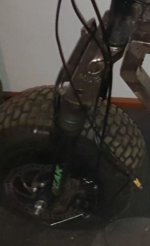Just curious. 'bike' implies pedals, and 'moped' is motor-pedal.
Have you checked if what you are building is legal in your jurisdiction? I imagine you probably have. In the place I have lived, that vehicle will require engineering proof that it meets all the legal requirements for a motorcycle, and that a company is willing to issue insurance for riding it (and that you have the insurance when you ride it).
Not everything that goes under the classification of moped has pedals around here, it used to be common but nowdays most dont.
Im building it to comply with feature set for bicycles when it comes to lights and reflectors.
There is a sub class called Elsparkcykel "Electric Kick Bike" which is what we call electric scooters around here, they have the requirements for bicycles, except for not needing pedals and the added limitations of 20kph and 250w max.
I doubt 250w will be enough for going up hills so that is likely going to be exceeded, tho i do intend to keep the speed at 20kph.
Im not all that worried tho, i used to ride a bicycle with one of those chinese bolt on 2 stroke kit motors for my commute to work and just around in general because i liked riding it, did that on an off for a year or three.
The motors are definitely illegal and easily visually identifiable as such because the only legal bolt on 2 stroke motors here are the ones that were sold pre-fitted on bicycles.
Which hasnt happened here for multiple decades, plus that they need to have been insured for all that time.
Which in turn means that there may be no legal bolt on 2 stroke bicycles left at all.
Passed a couple of cop cars going the other way with no issue, im not a 12 year old and i dont drive too fast so i guess the sight of me dont sting their eyes very much.
So me riding something looking like it fits in a legal category will probably sting even less.
As for what got done yesterday:
I drilled the holes for the seat, did final shaping of the foam with a sanding drum, cut the head tube from the bicycle frame, welded it to a plate and welded that to the miniebike.
Had a first roll down the slightly inclined yard at work and beyond sitting on two tubes, rather than a finished seat, that was nice



















